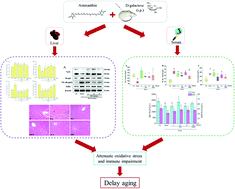Astaxanthin attenuates oxidative stress and immune impairment in d-galactose-induced aging in rats by activating the Nrf2/Keap1 pathway and suppressing the NF-κB pathway†
Abstract
As a potential antioxidant, astaxanthin (AST) exhibits anti-aging effects. However, its relationships to oxidative stress and immunity have yet to be sufficiently investigated. In this research, integrated analysis of oxidative stress and immunosenescence was performed to elucidate the efficacy and potential mechanisms of AST in D-galactose-induced aging in rats. The results showed that AST significantly decreased malonaldehyde (MDA) levels and increased antioxidase activity, in addition to demonstrating the ability to repair histopathological injuries to the liver, thereby attenuating oxidative stress. Nuclear factor erythroid 2-related factor 2 (Nrf2) expression was up-regulated by 117.95%, whereas Kelch-like ECH-associated protein-1 (Keap1) expression was simultaneously down-regulated by 51.22%. Moreover, AST significantly reduced interleukin-1β (IL-1β) and interleukin-6 (IL-6) levels, as well as expression of nuclear factor-kappa B (NF-κB) (p65) and i-kappa-B-alpha (IκBα) proteins. Findings of repair of immune organs, as well as elevated levels of interleukin-2 (IL-2), immunoglobulin M (IgM) and immunoglobulin G (IgG), suggest a novel mechanism by which AST could regulate cellular immunity and humoral immunity to attenuate immunosenescence. The anti-aging effects of AST were shown to be due in part to the Nrf2/Keap1 and NF-κB pathways, and AST treatment ameliorated oxidative stress and immune impairment overall.



 Please wait while we load your content...
Please wait while we load your content...